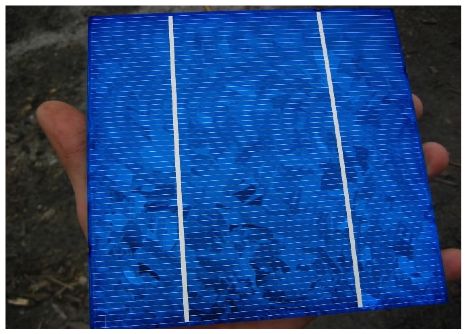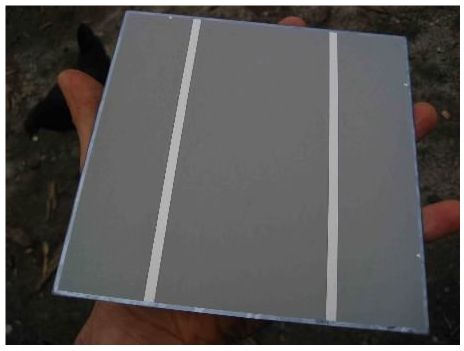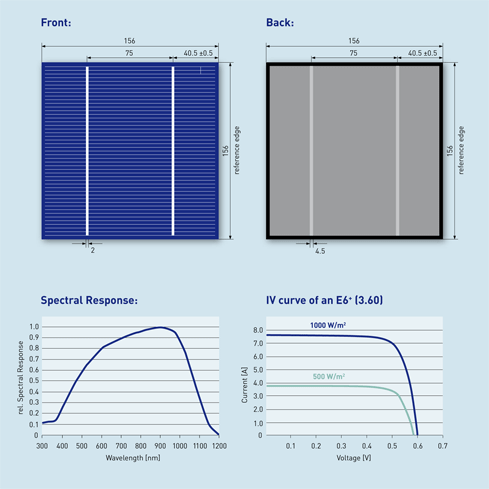Solar Cells: Difference between revisions
(→Links) |
No edit summary |
||
| (22 intermediate revisions by 9 users not shown) | |||
| Line 1: | Line 1: | ||
=Solar Cells= | {{Category=Solar Power}} | ||
{{We build a 2 kW system in 2007 starting with solar cells, tabbing and encapsulating by hand. [[Solar Panels at Factor e Farm]]}} | |||
=2021= | |||
*Used panels- $45 for 250W - [https://store.santansolar.com/product/santan-solar-t-series-250w-snail-trails/#reviews] | |||
=Solar Cells - 2008= | |||
These are the solar cells that we have from [http://www.ersol.de/en/products/solarcells/multicrystallinecells/solarcelle6bluepower/ Ersol] | These are the solar cells that we have from [http://www.ersol.de/en/products/solarcells/multicrystallinecells/solarcelle6bluepower/ Ersol] | ||
| Line 9: | Line 15: | ||
Recommendations for processing: | Recommendations for processing: | ||
* maximum of 24 cells per bypass diode | |||
* solder joint | |||
**tin-coated copper strips | |||
**2.3 mm x 0.15 mm | |||
Bypass diodes - [http://www.udel.edu/igert/pvcdrom/index.html] | Bypass diodes - [http://www.udel.edu/igert/pvcdrom/index.html] | ||
| Line 32: | Line 38: | ||
#1. alternatives to lead? lead free solder that still works for this application? given the lifetime of the panels and amount of PB necessarily a huge factor? | #1. alternatives to lead? lead free solder that still works for this application? given the lifetime of the panels and amount of PB necessarily a huge factor? | ||
#2. Width of solder? many sizes available, usually .31 and .75 are widely available. No guides | #2. Width of solder? many sizes available, usually .31 and .75 are widely available. No guides | ||
=Encapsulation= | =Encapsulation= | ||
| Line 43: | Line 46: | ||
=Soldering Leads to Solar Cells= | =Soldering Leads to Solar Cells= | ||
To solder your solar cells, you must use a tow temperature solder iron (if you have a variable temperature iron, set it for 280' C) Use only good quality resin or rosin core SN60, 60/40 or SN63 solder and follow these steps: | |||
1 Wear eye protection safety goggles or safety eyeglasses | |||
2.Set cell on a cardboard surface. | |||
3.Carefully scrape the metal bar on top of the cell with a hoboy knife or razor blade. Be very careful not to scrape too hard as you can easily break the cell The oar should be shiny where you have scraped. | |||
4.Now draw the tip of your iron and some solder across the bar where you have scraped it and the solder should adhere. Now, carefully attach a flexible 28 ga (small) lead to the sokler contact (youII have to reheat it). | |||
5.Note: if the solder just balls up:<br> | |||
a.Your soldering iron tip rs too hot<br> | |||
OR<br> | |||
b.You didn't scrape the bar properly | |||
6. After you have made your connection to the top, let it cool and then flip the cell over 7 You should not scrape the bottom as the solder will adhere without any special treatments. Just remember these facts | |||
a.On cells that have a dark gray background youH see squared off 'silver" areas to solder to. | |||
b.On all silver colored cell backs, solder to the "dull" looking areas only. | |||
=Practical Guides= | =Practical Guides= | ||
| Line 55: | Line 69: | ||
are the best guides so far. | are the best guides so far. | ||
=List of Solar Cell Manufacturers and Price= | |||
A list of international solar cell manufacturers can be found here: | |||
[http://www.enfsolar.com/directory/cell Solar Cell Manufacturers] | |||
A list of solar cells showing specifications and price can be found here: | |||
[http://www.enfsolar.com/pv/cell Solar Cell Database] | |||
=Further Information= | =Further Information= | ||
| Line 73: | Line 94: | ||
[[Solar Panels at Factor e Farm]] | [[Solar Panels at Factor e Farm]] | ||
=Links= | == See also== | ||
* [[Open Source Photovoltaics]] | |||
* [[Wind Turbine]] | |||
=External Links= | |||
*[http://www.sungroper.asn.au/project/solar-panel.html Solar Panel Construction]<br> | *[http://www.sungroper.asn.au/project/solar-panel.html Solar Panel Construction]<br> | ||
*http://pyronet.50megs.com/RePower/Homemade%20Solar%20Panels.htm<br> | *[http://pyronet.50megs.com/RePower/Homemade%20Solar%20Panels.htm Homemade Solar Panels - Pyronet]<br> | ||
*http://www.mdpub.com/SolarPanel/index.html<br> | *[http://www.mdpub.com/SolarPanel/index.html Homemade Solar Panels - MDPub]<br> | ||
*http://www.virtualsecrets.com/build-a-solar-panel.html<br> | *[http://www.goodideacreative.com/solarpanel.html Homemade Solar Panels - Good Idea Creative Services]<br> | ||
*http://www.siliconsolar.com/practical-photovoltaics-p-16423.html | *[http://www.virtualsecrets.com/build-a-solar-panel.html Homemade Solar Panels - VirtualSecrets]<br> | ||
*http://www. | *[http://www.siliconsolar.com/practical-photovoltaics-p-16423.html Book on PVs]<br> | ||
*[http://www.greenlivings.biz/home-made-renewable-energy/home-solar-energy/diy-home-solar-panels/learn-how-to-build-solar-panels-from-scratch Homemade Solar Panels - Green Livings]<br> | |||
Latest revision as of 16:52, 21 September 2022
Main > Energy > Solar Power
{{We build a 2 kW system in 2007 starting with solar cells, tabbing and encapsulating by hand. Solar Panels at Factor e Farm}}
2021
- Used panels- $45 for 250W - [1]
Solar Cells - 2008
These are the solar cells that we have from Ersol



Soldering Contacts
Recommendations for processing:
- maximum of 24 cells per bypass diode
- solder joint
- tin-coated copper strips
- 2.3 mm x 0.15 mm
Bypass diodes - [2]
Diode, 8 amp, $2.25 - [3]
Air Mass Calculation
In winter, the sun at high noon travels through an air mass of 2.2. See calculator at
http://www.udel.edu/igert/pvcdrom/SUNLIGHT/AIRMASS.HTM
This means that the solar irradiance available to the solar cells is about 0.8 kW per square meter, compared to 1 kW per square meter in summer.
Soldering
- SN60 40/60 and SN 63 is widely available in the plumbing section at your local/global enterprise hardware store. SN refers to tin, thus 60%, and the rest is lead.
Technique is such that a low power iron or variable power iron is required. High power is generally for plumbing applications. High power will cause the solder to ball up and be of little use. The guide below is the most detailed description we have of how to solder the leads or "tabs" to the cells. If anyone has more info on this topic let us know please!
- WORKING QUESTIONS:
- 1. alternatives to lead? lead free solder that still works for this application? given the lifetime of the panels and amount of PB necessarily a huge factor?
- 2. Width of solder? many sizes available, usually .31 and .75 are widely available. No guides
Encapsulation
- Information on encapsulation from Ebay - [4]
Comment: item appears to be unavailable; 2 negative feedbacks on item not being delivered
Soldering Leads to Solar Cells
To solder your solar cells, you must use a tow temperature solder iron (if you have a variable temperature iron, set it for 280' C) Use only good quality resin or rosin core SN60, 60/40 or SN63 solder and follow these steps:
1 Wear eye protection safety goggles or safety eyeglasses
2.Set cell on a cardboard surface.
3.Carefully scrape the metal bar on top of the cell with a hoboy knife or razor blade. Be very careful not to scrape too hard as you can easily break the cell The oar should be shiny where you have scraped.
4.Now draw the tip of your iron and some solder across the bar where you have scraped it and the solder should adhere. Now, carefully attach a flexible 28 ga (small) lead to the sokler contact (youII have to reheat it).
5.Note: if the solder just balls up:
a.Your soldering iron tip rs too hot
OR
b.You didn't scrape the bar properly
6. After you have made your connection to the top, let it cool and then flip the cell over 7 You should not scrape the bottom as the solder will adhere without any special treatments. Just remember these facts
a.On cells that have a dark gray background youH see squared off 'silver" areas to solder to.
b.On all silver colored cell backs, solder to the "dull" looking areas only.
Practical Guides
http://www.sungroper.asn.au/project/solar-panel.html
and
http://www.goodideacreative.com/solarpanel.html
are the best guides so far.
List of Solar Cell Manufacturers and Price
A list of international solar cell manufacturers can be found here:
A list of solar cells showing specifications and price can be found here:
Further Information
From Richard Schulte:
Most of the guides I have seen have all said the exact same thing about soldering the cells together. The process seems to be simple and more time consuming than anything. When it comes to encapsulating, however, there is a large amount of variance, though more people use plexiglass than I had thought would. Several guides have suggested the same sealant:
http://pyronet.50megs.com/RePower/Homemade%20Solar%20Panels.htm
Edit: I've been informed that fiberglass resin is a polyester resin and will not hold the moisture out very well. The best thing to use, which I'm switching to is a aluminum epoxy type sealer called ALUTHANE which can be found Here. <http://www.epoxyproducts.com/e_nonepoxy.html>"
We need to make sure you have the right kind of soldering iron as well. It must be fixed at low temperature or have a variable temp, or else the kind of solder we are using will ball up. One site, http://www.mdpub.com/SolarPanel/index.html, suggested mounting them on pegboard, and using silicone caulk to attach them.